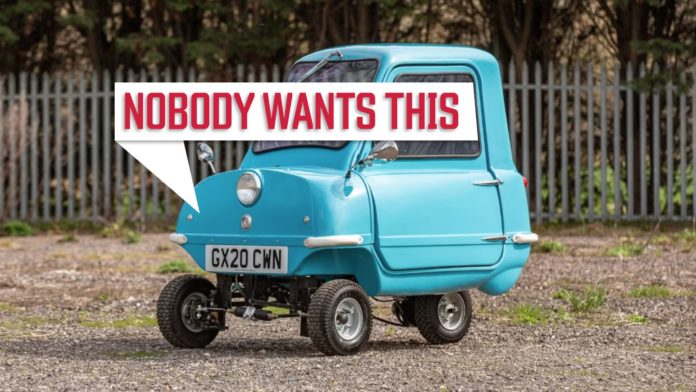We don’t mean to get too abstract here, but do you ever wonder how we decided on the general shapes and body types you see on the road? How did we settle on sedans being roughly four and a half feet tall, six feet wide, and fourteen feet long? And why are pickups like the Ford Maverick the only vehicles you see with a cargo box in the back?
Take a look at the worldwide auto market, and you’ll see that vehicles are shaped by a number of factors including what is required of the car, emissions and safety regulations, economic realities, and even the local climate. There are entire segments that only exist because of things like tax laws and import restrictions, and cars we never get here in the States as a result. Here are a few segments that simply never caught on in the U.S., whether for legal, economic, or cultural reasons.
Shooting Brakes
For many readers, this is the first time you’ve even seen this term. That alone may help to explain why this body type never caught on in the US. The truth is, shooting brakes are a bit of a niche segment even in their country of origin. A blend of station wagon and coupe body styles, the name refers to horse-drawn wagons used to transport hunting teams or sports shooters. A “brake” was a heavy-drag chassis with braking capabilities, so you get “shooting brake.” There’s some hair-splitting going on around the exact characteristics of a shooting brake, but “two-door station wagon” is about as good a definition as any.
Related
Greatest Shooting Brakes Of All Time
There’s nothing like a sporty 2-door wagon.
To an American driver, a Shooting Brake, like a Volvo 480, is the worst of both worlds. You have the cramped layout of a two-door coupe, with the cumbersome dimensions of a station wagon. In the U.K., it’s a fuel-efficient alternative to larger sedans, minivans, and SUVs like the Range Rover.
In the US, it solves a problem we don’t really have. If we want more seating or additional trunk space, we’ll buy an SUV. If we want a coupe, we’ll buy a coupe. The fact that minivans largely usurped the station wagon in the United States through the 1980s and 1990s, and crossovers largely overshadowed the minivan into the 21st Century, leaving only a few models like the Honda Odyssey and Chrysler Pacifica in their wake, underlines the different priorities between English and American drivers. Basically, gas is cheaper here, and if we want a larger car, we’ll just buy a larger car.
Coupe Utility Vehicles
The term “utility vehicle” doesn’t even mean the same thing in every country. In Australia, for instance, pretty much anything that’s off-road capable is called a “ute” (pronounced yoot). To clarify, we’re talking about coupe utility vehicles, which are cars like the El Camino, Subaru Brat, and Ford Ranchero. Coupe utilities have been trialed in the United States more than a few times, and cars like the Ford Durango and Dodge Rampage have their fans, but utes have always been a rather small segment in the U.S., and they’ve essentially gone AWOL since the El Camino was retired in 1987.

Add CarBuzz to your Google News feed.
The answer to this one is pretty simple in that compact trucks are a thing. By the end of the 1980s, Americans had the Toyota pickup, Ford Ranger, Chevy S10, and the Mazda B-Series to pick from, just to name a few. These trucks were typically cheaper and more fuel-efficient than coupe utilities. For instance, a 1987 El Camino started at an MSRP of around $11,000, while an entry-level 1987 Ford Ranger could be had for under $7,000. By the end of the decade, you could just about buy a car and a truck for the price of the weird car-truck compromise, so the ute, already limited in its appeal in the U.S., naturally fell out of fashion.
Tiny Cars
We’ve got our share of small cars here in the U.S., but tiny would be a stretch. You can buy an eleven-foot Fiat 500, and the mostly-forgotten Scion iQ stretched just ten feet from nose to tail. What we’ve never seen in the U.S. on any real production level is something to match Japan’s kei car market, or European microcars.
If you ask most people why that is, they’ll tell you “Americans like big cars,” but does that argument really hold any water? The two-seat Porsche 911 is a dream car for many Americans, and we bought 11,728 of them in 2023. Ford’s smallest truck, the Maverick, sold 94,058 units last year, and it’s already sold 135,199 for 2024, as of mid-October. We don’t necessarily need vehicles to be as big as possible over here. A better question may be how cars got so tiny in Japan and Europe.
Japanese Drivers Pay Taxes Based On Vehicle Size
In Japan, you can’t just buy a car. You have to rent or own a personal parking space before you can even put in a down payment, and you’re taxed based on the size of your car. And taxes don’t just apply to the sale price and registration fees, either. Every April, Japanese drivers pay a tax, assessed that fiscal year, for simply owning a car, with the revenue to be paid toward road maintenance.
The exact rate you’re going to pay for your car will vary year after year, but larger cars are always taxed at a higher rate than smaller ones, with the initial sales tax coming out to 5% for a typical sedan, or 3% for a kei car. In America, sales tax isn’t affected by size class, so we don’t really need kei cars like the Honda Beat (and they don’t make a lot of sense on American highways anyway)
.

Related
The Suzuki Hustler Tough Wild Is A Ridiculously Named Kei Car With Loads Of Character
The tiny Hustler Tough Wild makes the Jimny look like a Land Cruiser, but that doesn’t stop us from wanting one.
Post-War European Microcars Were The Result Of Limited Resources
Why else would you build a three-wheel car you can fit in the trunk of a Toyota? We can’t imagine a manufacturing executive legitimately believing clown cars to be the future of the auto industry. Given the limited resources available in the post-war economy, motorcycles were very popular in Europe for their fuel-efficiency, and because they were taxed at a lower rate, and microcars came with all those same advantages, but you could drive them in less-than-ideal weather. Meanwhile, gas prices remained pretty steady in the U.S. throughout this era. In 1949, we were spending 27 cents a gallon and in 1969, 31 cents a gallon. In England, the cost of gas more than doubled in that same stretch of time.
Microcars saw an initial boom lasting through the 1950s, which would end with manufacturers like Mini, Fiat, and Renault eventually squashing the segment with the release of agile, affordable city cars with far greater power under the hood in the late 1950s and early 1960s, including the Renault 4, Mini Cooper, and the Fiat Nuova 500. The 1961 Renault 4’s initial engine, a 21-horsepower 3MT, wasn’t exactly a Cobra Jet, but put it next to a one-cylinder, five-horsepower 1949 Bond Minicar, and the 4 is practically a Dodge Challenger SRT Hellcat. It’s no wonder the British fell out of love with the microcar as soon as these larger economy cars came along, and it’s no wonder Americans weren’t that interested in European cars until they made something big enough to seat a driver and a pack of cigarettes, at the same time.

